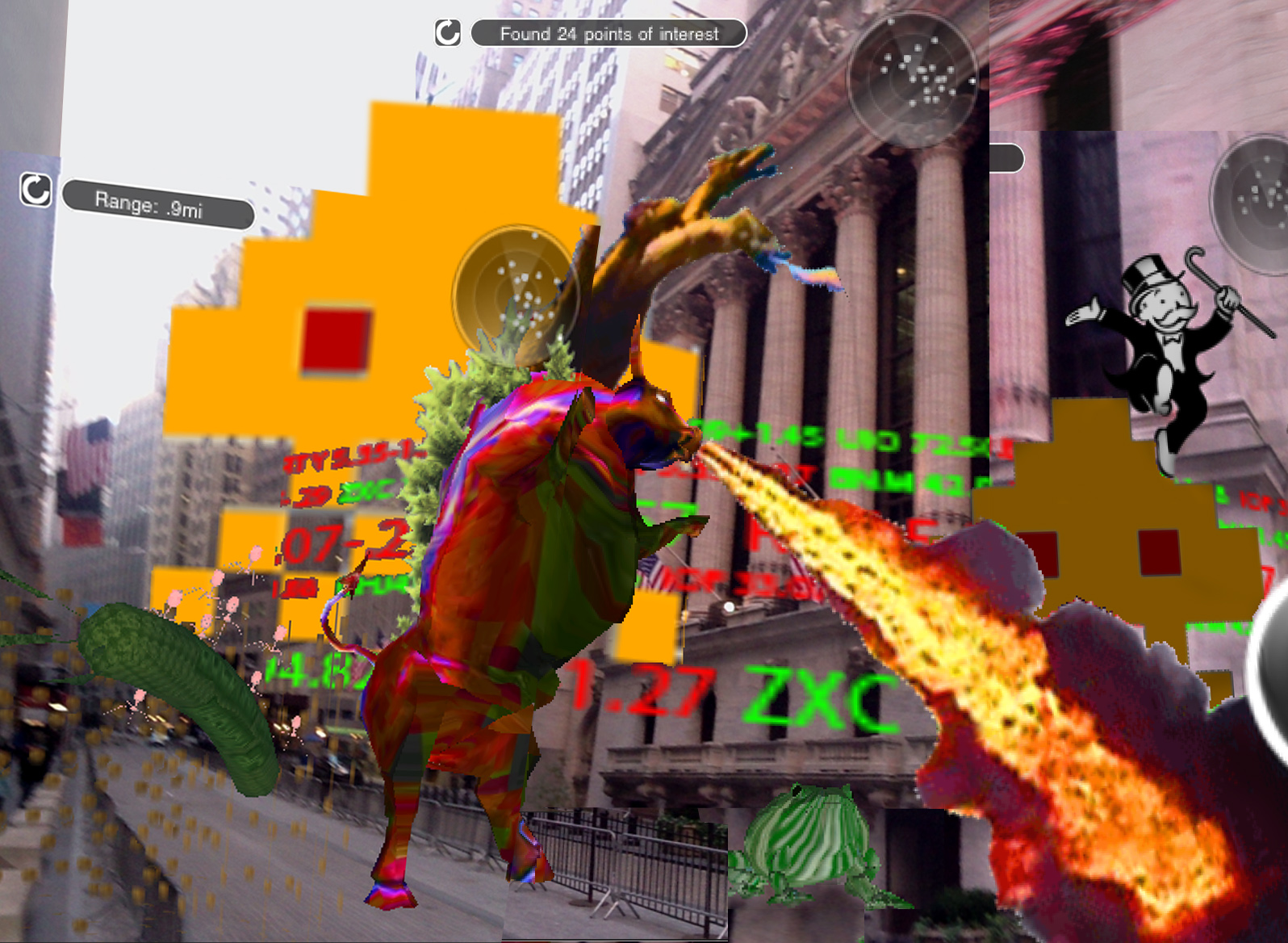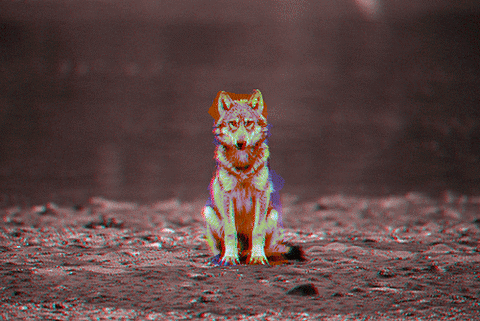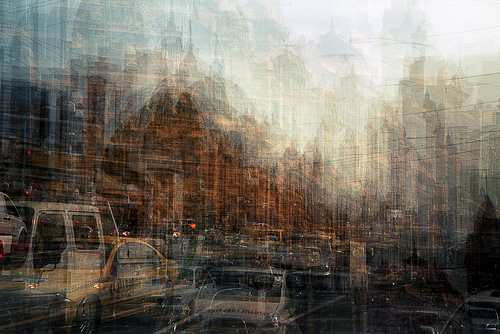Playfulness and Processuality:
An Interview with Bruce Sterling about the New Aesthetic
12 Sep 2012
Note: “Playfulness and Processuality” will be published in the upcoming issue of the new print magazine The Alpine Review. David Cox performs live for OTHER CINEMA’s Optronica show on Saturday, November 10, 2012!

Occupy Wall Street AR by Manifest.AR (Space Invaders by P. Lichty)
The New Aesthetic is a term coined by publisher and designer James Bridle. James Bridle’s website is here.
Simply put, the New Aesthetic concerns itself with how the digital world and the real world are starting to overlap and intermingle in interesting, routine, and unexpected ways. As search engines, online “bots,” spam generation engines, online mapping tools, Google Street View, machine vision and sensing technologies proliferate, our everyday life in the western technologically-advanced world is starting to bristle with new types of augmentation and hybridity.
Post-9/11 security apparatus, pilot-less sensor-studded drone devices, biometric tracking systems, the ways that computer vision creates unusual and often funny mistakes and glitches, the unique properties of bitmap graphics, the staircase look of pixels in close-up. The unintended consequences of so many “smart” sensors and cameras released into a largely apparently culturally unprepared society; all this is the raw material of the so-called “New Aesthetic.”
Like many early aesthetic movements, the New Aesthetic (NA) is deeply romantic. It thinks it sees ghosts where there are none; “bots” online that can think for themselves. The photoshopped people in CGI architectural images at construction sites. The NA’s poster child James Bridle insists, for example, that spambots are evidence of attempts by “the machines” to communicate with us, the humans. Would that we could only listen to them, he insists, in his talk “Waving at the Machines,” and an Asimovian full acceptance of these new emergent clumsy intelligences might be possible.
Banks and the super-rich behave much like the soulless commercial AIs they unleash to do their high-stakes bidding for them. When money circulates and is stolen with impunity on the unthinkable scale it is in today’s global “market” and entire economies collapse overnight, it must be tempting to read intelligence into this epochal and tragic worldwide dance of ruin.
Like many early aesthetic movements, the New Aesthetic is deeply romantic. It thinks it sees ghosts where there are none; “bots” online that can think for themselves.
In its universalist techno-spiritualist reverie/angst, the NA has much in common with the steam and clockwork enamored early modernist London Victorian middle class and its preoccupation with spectres and seances.
Even Karl Marx was taken with the hooplah—hence the half-joking beginning of the Communist Manifesto “A spectre is haunting Europe....” Karl knew the then hyper-new idea of Communism was viewed by its “opponents in power” as a ghost to be exorcised from its places of origin; the factories and offices of late 19th-century Europe. In our time, that of Eurozone meltdown and Dronewar International, the new ghosts are not so much the New Aesthetic’s fanciful kinnect hack render glitches or bitmap t-shirts, or street-view images of our land/datascapes, but rather the actual streets afire in Greece, Syria, and everywhere else tyranny is meeting its match by a livid population.
Smoke and mirrors, rather than render ghosts and glitchcore of today’s retina displays, provided the spooky effect back in Victorian London. Today, it is a world that fuses Bansky-style political Hoxton street art with a genuine and understandable fear, terror even, of the unseen, everywhere-at-once unmanned aerial drone, a truly laudable sympathy for and working alongside the global Occupy movement, a wry, British whimsical ironic take on what amounts to an Amazon-ian Apple-ized Google-ization of culture, mediated by ever-ubiquitous smart sensing devices. This is a world in which the environment itself can somehow tell if you are or are not on side with Big Plans for the Future made on your behalf. Its a Spime World After All.
Our challenge: How do we contest so diffuse and so ubiquitous and so hegemonic and spectacular today’s global, digitally mediated “mirrorworld”? The antidote to all this control culture, as it was for those in the England in the ‘50s, ‘60s, and ‘70s was and is...playfulness.

you-dont-compare, Wolf. via The New Aesthetic
The Beatles and Pink Floyd adapted the fey, dandyish Lewis Carrol UK brand of psychedelic surrealism to otherwise economically struggling, drab postwar England. The BBC Radiophonic Workshop and Monty Python’s Flying Circus, both genteel surrealist (if rather gentle) refutations to the constraints of UK authority offered (albeit encoded and implied) semi-secret electronically mediated ways out of grey Official England. Punk slapped symbolically the Queen’s face, and hard. But all were playing. Playing with the conventions of style. Inverting the uses of things—recording equipment, television programming, the singles charts, fashion. So it is with the New Aesthetic. Playfulness and processuality.
So today’s brand of UK surrealism performs a similar inversion trick with resources that befit the contemporary British Alienated Middle Class Experience—software, Photoshop, plugins, object-oriented programming, kinect hacks, arduino kits, DIY drones, quadrocopters, mapping tools, GIS, social media, online commerce, amid a world being increasingly shaped and controlled for profit by ever fewer corporate interests. If punk and psychedelia had its programming contingent, here they are.
Perhaps unsurprisingly the New Aesthetic has emerged from London, specifically, the digital publishing and user interface design hotbed of Hoxton/Shoreditch, but its cultural influences in the two years since the term was first introduced have been felt globally. Hoxton is hipster ground-zero in the UK, and most of the best ideas in the UK end up here one way or the other.
How do we contest so diffuse and so ubiquitous and so hegemonic and spectacular today’s global, digitally mediated “mirrorworld”? The antidote to all this control culture, as it was for those in the England in the ‘50s, ‘60s, and ‘70s was and is...playfulness.
My dear London steampunk, please meet your render ghost with her face blurred out by Google Street View. And please see here the unofficial NA logo: a silhouette of a predator drone being carried away “UP” style, by a bunch of helium balloons. Terror device symbolically defused.
I asked Cyberpunk Science Fiction writer and design-fiction futurist Bruce Sterling some questions about the New Aesthetic, as I was intrigued by many of the ideas that he expressed in his WIRED-hosted blog Beyond the Beyond. Sterling is ambivalent about the more mystical/obscurantist aspects of the NA, with its insistence upon supposedly quasi-sentient bots of the Gibsonian Wintermute (and Summerblind?) variety out there thinking and acting for themselves online.
But he is also very optimistic about the movement, seeing in it (as indeed do I) evidence of a fresh and welcome feeling of excitement in contemporary digital culture. The New Aesthetic he argues, has freed up the imagination of creative people working with digital resources. It lets us creatives think in new ways about what we do. Ways that offer a conceptual direction away from the mere tools alone.

MVRDV; The Cloud, Seoul via The New Aesthetic
David Cox: Is what we are experiencing/have experienced with the “New Aesthetic” really new or is it part of something really new or is it part of an older discussion? The reservations you expressed in your WIRED essay seemed to reflect a concern about the form that it took, suggesting that you did not think that is was formed enough, that the Tumblr of images was a “collection of jackstraws,” I think was the metaphor you used. [Your argument was] that the images of drones, bitmaps, maps [were not really] tantamount to a movement, that there’s not much rigor there and that it does not really constitute a sufficiently-focused enough strategy to change things, although this is a generation that knows no other way to formulate its views. Its relation to the broader culture is one mediated by social media, and so has a more diffuse form?
Bruce Sterling: First to the issue of “is the New Aesthetic really new?” I’d say those images are “new” pretty much by definition. Aesthetics obviously is very old. James Bridle doing a project called The New Aesthetic Tumblr is over, and receding into the past. But machine-generated imagery that is unlike previous forms of imagery is all over the place. So, yes it is new, for any reasonable definition of novelty.
At least it’s possible to imagine a strategy now—instead of merely saying, “I’m an artist, but I do digital electronics,” you can re-frame your efforts as something like “a new aesthetic of processual vital beauty,” and you’re not so handcuffed to the soldering irons.—Bruce Sterling
As for whether James Bridle’s image collection had any analytical rigor, I’m inclined to think he had more analysis going on there than he liked to let on; but I rather think James prefers writing, journalism, and publishing to the trying role of a public New Aesthetic visionary. When you have a breakout viral hit on the Net nowadays, the opportunity-cost can be pretty stiff.
On the issue as to what a New Aesthetic ought to do, what the “strategy” is, well, that’s unsettled, but I think that James’ year-long intervention there has raised the morale of tech-art people quite a lot. It’s legitimated their practice in their own eyes, and helped to free them from their traditional hangups on specific pieces of hardware. At least it’s possible to imagine a strategy now—instead of merely saying, “I’m an artist, but I do digital electronics,” you can re-frame your efforts as something like “a new aesthetic of processual vital beauty,” and you’re not so handcuffed to the soldering irons.
On the generational issue, there’s some anxiety among the aging that people under 30 actually think like Tumblrs nowadays—that they’re unmotivated and diffuse, or in the shallows, or mentally crippled by too many pixels—allegations along that line. Obviously they’re a troubled generation, but Tumblrs are not major problems to rank with a major Depression dominated by dogmatic gerontocrats. If we’re going to get generational, then we ought to start the discussion with the amazing mental stasis of Baby Boomers, people who used to be exceedingly reckless and inventive and haven’t had a single new idea since 2008.

Matthew Day Jackson, GEM via The New Aesthetic
DC: How British is the New Aesthetic? How “London” is it—is it global? Should the global aspect be considered from the US or broader European perspective aspect?
BS: How British is it? It’s pretty British. How British is anything nowadays? You can always make a claim that, say, the Beatles aren’t British but mere Elvis imitators. London is a big center of interface-design these days. I think the New Aesthetic is strongly related to British interface-design thinking: there’s this black box, and then there is our considered and erudite set of reactions to that black box, our way to deal with it.
DC: On the new deus-ex-machina/ghost-in-the-Machine—so-called “render ghosts,” spambots as sentient beings and all that. There is kind of naive mystical occultism that you criticize in your WIRED article. You argue that machines are not inherently “friendly.” Bridle’s yearning for a communication with machines speaks to a kind of a gnosticism; a kind of Terence McKenna sensibility. The fascination with patterns between things, particularly spambots and the like, the ways algorithms generate odd syntax as evidence of attempts to communicate with us humans. New Aesthetic is not embodied in the individual images or modes of communication but perhaps in a fascination with connections between them.
If New Aesthetics is bringing something new here I think it’s “processuality.” It’s about the aesthetics of watching the code run, as opposed to static printouts of code as psychedelic underground comix.—Bruce Sterling
BS: On the mysticism issue, the render ghosts and the desires of the machines and so forth, yes, I think that’s a major failing. I think it’s self-deceitful and is likely to get in the way of good work. On the other hand artists are often mystics—it’s like the attitude that there’s a living god in this block of inert marble, and I have to release him with a hammer and chisel. A lot of great art is based on colossal superstition. Just visit the Vatican sometime.
I take your point about gnosticism and Terence McKenna, but if that’s the path one wants to choose the endpoint is psychedelic art. There’s digital glitchcore New Aesthetic stuff already that looks a bit like bad-trip psychedelia, it’s like paisley swirls as 8bit pixels. The problem with psychedelic art is that the art doesn’t develop and the drugs lose their charm.
If New Aesthetics is bringing something new here I think it’s “processuality.” It’s about the aesthetics of watching the code run, as opposed to static printouts of code as psychedelic underground comix. The issue of social relations, of finding meaning through the network, that’s very important but also metaphysical—it’s about how we know what we know. It’s an issue of “media philosophy.” Problems here which used to be quite speculative and farfetched are becoming urgent. I’m hoping for rescue.

Roberts Birze, The 75 Tram on Flinders Street via The New Aesthetic
DC: Aggregation. Your excellent talk at the European Graduate School on “Atemporality and the Passage of Time” brought together a similar approach to that of the New Aesthetic and I was wondering if you saw this as perhaps evidence of a general trend. Your slide show/Flickr set seemed to favor images of expressions of the uncanny. Images that show ideas that appear to occupy two time periods simultaneously. In fact Bridle uses computational re-photography in his talk “Waving at the Machines.” We might call it a “strategy of aggregation.”
BS: “Strategy of aggregation” is an interesting way to frame the network-society habit of burying people in lateral cruft. Today I watched a tidal wave of Twitter grief over the death of Ray Bradbury—bad enough that I should learn he’s dead, but there’s also a “strategy of aggregation” where I’m confronted with a sandstorm of wails of pain, so many that you’d think the natural death of this 91-year-old gentleman was equivalent to, say, an earthquake or hurricane. My strategy on Twitter is obviously to aggregate a whole bunch of guys who know who Ray Bradbury is, but the social effect of this kind of reaction is new and different—is Ray really more important than an earthquake? How can one judge that?
The New Aesthetic is a deliberate attempt to break this steampunk stasis of atemporality, to get things rolling again by emphasizing the genuinely novel aspects of our contemporary experience.—Bruce Sterling
Is it atemporal? Well, it’s certainly not. In fact it’s a deliberate reaction against atemporality, the New Aesthetic is about as anti-atemporal as one can get. It always interests me a lot that people who don’t understand atemporality don’t understand the New Aesthetic, either. The New Aesthetic is a deliberate attempt to break this steampunk stasis of atemporality, to get things rolling again by emphasizing the genuinely novel aspects of our contemporary experience. But atemporality is quite strong and just saying that you don’t care for it, or that you find it limiting, isn’t enough to defeat it. The defeat of atemporality will have to come through lived experience. I hope it doesn’t require a big catastrophe, like the way the First World War abolished the happy-time neurasthenia of the Belle Epoque.
Then there’s the issue of James Bridle doing tech-artsy things with print and publishing. He is a publisher, but I think other hacker-artist figures find a lot to admire in these interventions of his. It’s easy to be, say, a member of BERG doing strange augmented-reality comic-book experiments and to see that James Bridle is a fellow-traveller, somebody who gets it. Where you go with it after you get it, that’s another matter. A matter as yet unknown.
◊
Bruce Sterling is a writer and futurist—Beyond the Beyond is his blog.
email: bruces@well.com
David Cox is an award winning filmmaker, digital media artist, writer, animator, and cultural critic who has lived and worked in Britain, the United States, and Australia. He is based in San Francisco. He is employed as a lecturer part time at the Design & Industry Department, San Francisco State University. He is the author of Sign Wars: The Culture Jammers Strike Back!, and the 80-page novella Dr. Yes and the Mystery of the Mission (first published in OTHERZINE over ten issues), to be released by Ledatape Books in October 2012.
davidalbertcox.com
Coxblog
email: davidalbertcox@gmail.com